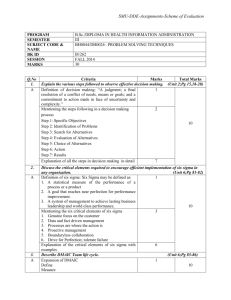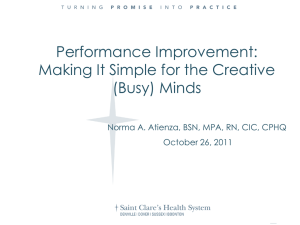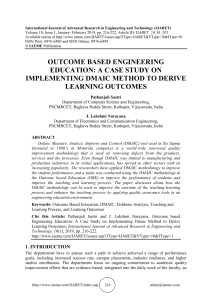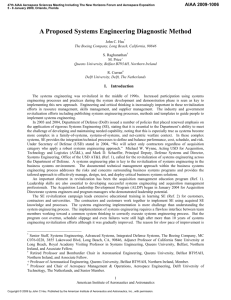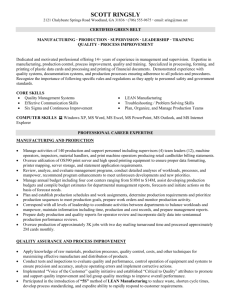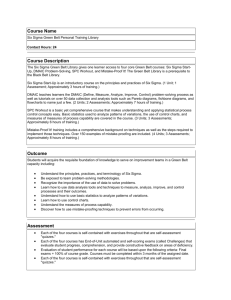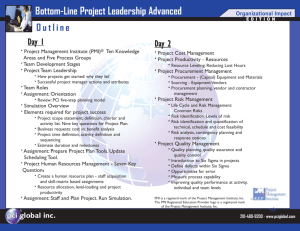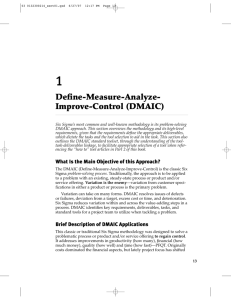Applying the DMAIC Steps to Process Improvement Projects
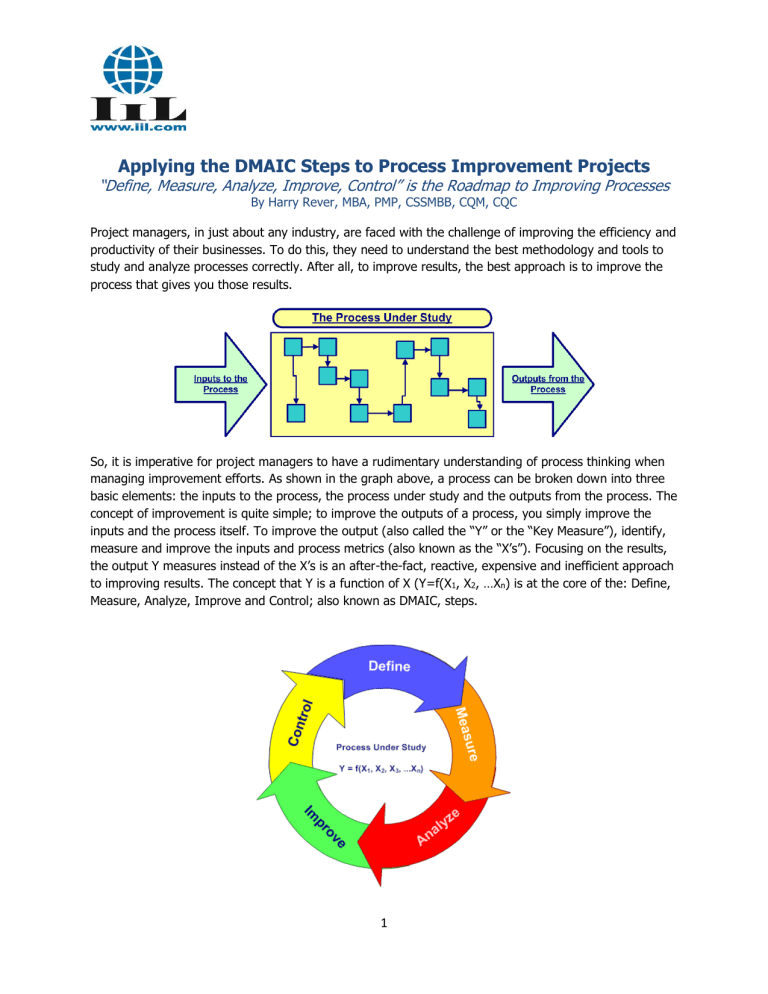
Applying the DMAIC Steps to Process Improvement Projects
“Define, Measure, Analyze, Improve, Control” is the Roadmap to Improving Processes
By Harry Rever, MBA, PMP, CSSMBB, CQM, CQC
Project managers, in just about any industry, are faced with the challenge of improving the efficiency and productivity of their businesses. To do this, they need to understand the best methodology and tools to study and analyze processes correctly. After all, to improve results, the best approach is to improve the process that gives you those results.
So, it is imperative for project managers to have a rudimentary understanding of process thinking when managing improvement efforts. As shown in the graph above, a process can be broken down into three basic elements: the inputs to the process, the process under study and the outputs from the process. The concept of improvement is quite simple; to improve the outputs of a process, you simply improve the inputs and the process itself. To improve the output (also called the “Y” or the “Key Measure”), identify, measure and improve the inputs and process metrics (also known as the “X’s”). Focusing on the results, the output Y measures instead of the X’s is an after-the-fact, reactive, expensive and inefficient approach to improving results. The concept that Y is a function of X (Y=f(X
1
, X
2
, …X n
) is at the core of the: Define,
Measure, Analyze, Improve and Control; also known as DMAIC, steps.
1
The roadmap for improving processes and key measures of a business is a straightforward, easy to understand set of those five steps. DMAIC is an iterative process that gives structure and guidance to improving processes and productivity in the workplace. Project managers and Six Sigma practitioners apply the DMAIC steps and appropriate analysis tools under each step, to analyze and improve key metrics of a business. Metrics are established, variation is studied and reduced and processes are improved and optimized. The result is improved performance, fewer errors and increased efficiency and productivity.
The DMAIC steps are the true backbone of any process improvement initiative. The steps make sense, they are easy to understand and they are logical in their sequence. The steps allow a team to adequately scope the problem, measure the current performance, analyze the root causes of problems and inefficiency, test and verify improvement recommendations and then implement changes for sustainability over the long haul. Process improvement projects are the norm these days. Improving key measures is something every project manager is going to be faced with sooner or later; therefore, a project manager should be skilled in the art of applying the DMAIC steps to improve results.
Understand the Process and then Measure the Process!
The DMAIC steps work because they are understandable and make sense. These steps can be applied to any process, any industry, any company to help guide a process improvement team. Before they can be applied, however, the project leader should lead his or her team to scope the problem, perhaps using a
Supplier, Input, Process, Output, and Customer or SIPOC diagram as shown below. Using the SIPOC tool can help project managers scope the problem, think in terms of processes, and help the team pinpoint what and where to measure. The SIPOC tool helps link metrics to the inputs, the process, and the outputs thus allowing for the Y=f(X) thinking.
2
The SIPOC tool is something than can be done in the Define step of the DMAIC steps.
DEFINE
Essentially the purpose of the Define step is to set your project up for success. Project managers are familiar with the things that need to be done when starting off a project. Essential project elements are accomplished in this step, such as:
Attaining sponsorship for the project
Establishing the project charter and appropriate scope
Identifying stakeholders and team members
Establishing team ground rules
Planning and conducting a successful kickoff meeting
In addition to the normal project deliverables listed above, for a process improvement effort, the project manager would facilitate his or her team in developing an “As-Is” process map. This will help the team not only get on the same page in terms of the process, but also will help the team identify problematic steps in the process. Process maps, or Deployment maps (a.k.a. Swim-lanes), can also be useful in identifying non-value added steps and can be vital in determining process measures.
Lastly, the team may require some basic training on the application of the DMAIC steps so that everyone knows what to do and when to do it.
MEASURE
The Measure step is often a step which, unfortunately, is skimmed over by most teams. One of the biggest mistakes made when trying to improve results is to make decisions based on “gut” feeling, intuition or anecdotal information. Instead, what is imperative is to base decisions on facts and data and that is the main goal of the measure step. In the Measure step, the team should:
Identify and operationally define key metrics
Develop a data collection plan
Conduct a measurement system analysis to verify that the data is accurate
Stratify the data
Establish baseline charts
Make charts and graphs to help the team better understand what the process is currently delivering in terms of processing times, errors or defects
3
ANALYZE
The Analyze step is all about getting to the root cause of the problem. Too often when trying to solve a problem, people or teams tend to focus on a symptom as opposed to the true root cause of the problem. The tools and techniques in the Analyze step lead project teams to gather clues for improvement and ascertain what the root cause, or causes, are that are the most important drivers. The
Y is a function of X formula is at play in the Analyze step. A team will analyze the process, perhaps using value-added analysis, statistical analysis, or maybe a fishbone chart, a cause and effect diagram, to get to what they think are the root causes. Then the team would gather data on the root causes to determine if there is a cause and effect relationship with the problem. Verifying cause and effect is a crucial step in the Analyze phase; a step which many people, unfortunately, skip or simply take for granted based on their opinions.
IMPROVE
Once a team moves through the Define, Measure and Analyze steps, they are now ready to use what they’ve learned about the process to be innovative when solving the problem at hand. Improve is the step where creative solutions to existing problems can be developed and tested, using various experiment or piloting techniques. The key deliverable in the Improve step is verifiable improvement through measurement. The best ideas for improvement, based on what was learned in Measure and
Analyze, are tested and implemented on a limited basis to determine if there is statistical evidence of sustained improvement. Once a team improves a process, the results should become quite clear on a control chart. When stakeholders can see the proof of improved performance, they will be more likely to accept and actually implement the team’s recommendations. Improve is about taking the emotion out of decision making. Improve is about verification and validation of recommendations. Often times, teams make the mistake of thinking they “know” what will work. Thus, they blindly implement what they think is the best solution without proper testing. The result, more times than not, is that there is no measurable or sustainable improvement.
CONTROL
The real strength of the DMAIC steps is the Control step. Too often, teams do a lot of hard work, actually improve the process and results, and then implementation of the improved process doesn’t go smoothly. There is pressure to move on; time isn’t spent on having a smooth transition and the buy-in for full implementation just isn’t quite there. The result is that sustaining the improvement realized in the
Improve step becomes difficult. The purpose of the Control step is to ensure a successful implementation of the team’s recommendation so that long-term success will be attained. The new and improved process will be flowcharted and these new methods will become the new standard operation procedures. Results will continue to be tracked so that any “drift” back to previous results can be monitored and addressed in a proactive manner. The Control step is about the transfer of responsibilities and establishing plans for long-term process control.
4
Making Better Decisions
Once the DMAIC steps are understood, then managing the process of how to improve results becomes clear and straightforward. If used properly, the following decision tree can lead to better decision making by helping business leaders ask the right questions to avoiding making knee-jerk reactions. Instead, it encourages an understanding of variation and reinforces the use of the DMAIC steps to address as the roadmap to continuous improvement.
5
In Conclusion
The DMAIC steps are a proven roadmap for any process improvement project. There are only five steps so they are relatively easy to remember. They offer a structured approach to solving problems and improving results. There are certain questions to be addressed under each step and certain tools and techniques can be utilized to answer those questions through facts and data.
When the DMAIC steps are properly applied, they offer any project team an organized approach, a structure, to solving key business problems. The DMAIC steps are flexible and can be used in any industry or with any type of process improvement effort. They just make sense, which is why they are so powerful. Every team leader should be familiar with, and incorporate, the DMAIC steps into all process improvement projects.
About the Author
Harry Rever (MBA, PMP, CSSMBB, CQM, CQC) is Director of Lean Six Sigma for International Institute for Learning
(IIL). A dynamic presenter and practitioner, he has trained thousands of employees on Six Sigma, process improvement and project management. He is a senior member of ASQ and a member of PMI. Harry can be reached at harry.rever@iil.com
.
About International Institute for Learning, Inc. (IIL)
IIL delivers learning and development solutions that help people and organizations succeed. We specialize in training and certification, coaching and mentoring, consulting and customized course development in the areas of Project,
Program and Portfolio Management; Business Analysis; Lean Six Sigma; Agile; Leadership and Interpersonal Skills.
Learn more about the Lean Six Sigma Certification Program and browse our full curriculum at www.iil.com
.
6
